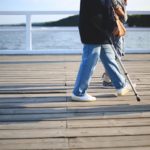
Walking is one of the easiest ways to add exercise to your day and to burn fat. The recommended amount of walking for weight loss is 60 minutes a day. Walking burns about 100 calories per mile for a 70 kg person. Brisk Walking Brisk walking means walking fast enough to make you feel slightly breathless but yet comfortable enough
Read More …
Frozen Shoulder – Prevention – Early treatment helps prevent stiffness and keep diabetes under control as it is one of the risk factor..
Frozen Shoulder – Symptoms – Pain and persistent stiffness in the shoulder joint.. Frozen Shoulder – Causes – Cervical disc disease of the neck, Chronic illness like diabetes or arthritis, Women in post-menopausal age, Shoulder injury.
Frozen Shoulder – Treatment Using Home Remedies, Yoga, And Diet – Foods to be taken Foods to be avoided: Increase intake of anti-inflammatory foods such as fruits and vegetables, oily fish (which contain high levels of omega-3 fatty acids), nuts, seeds, and certain spices, such as ginger, garlic, turmeric. Vegetables like cauliflower, broccoli, brussel sprouts, cabbage, cress, sweet potatoes are all loaded with antioxidants that can help rid the body of harmful compounds. Fruits like berries, pineapples, red grapes are well regarded for their anti-inflammatory properties.
Frozen shoulder (sometimes called adhesive capsulitis of the shoulder) is a condition characterized by stiffness and pain in the shoulder joint..
Chondromalacia Patella – Prevention – Maintain a healthy weight to reduce stress on your knees, Properly warm up before exercising or doing any physical activity, Maintain proper strength by exercising the quadriceps, calf muscles, and hamstring muscles, Use proper footwear for your sport.
Chondromalacia Patella – Treatment Using Home Remedies, Yoga, And Diet – Foods to be taken Foods to be avoided: The knee-friendliest fruits appear to be vitamin C?packed ones, like kiwi, orange, mango, grapefruit, and papaya. The vitamin C in fruit protects the knee joint and supporting structures. Omega-3 fatty acids found in fish may block not only the chemicals that cause inflammation in osteoarthritis but also the proteins known to wear down knee cartilage. So eat two servings of oily fish (such as mackerel or salmon) weekly. Eat a nutritious diet with enough calcium and vitamin D, which helps your body absorb calcium. Calcium is found in dairy products, such as milk, cheese, and yogurt; dark green, leafy vegetables, such as broccoli; and other foods.
Chondromalacia, also known as runners knee, is a condition where the cartilage on the under surface of the patella (knee cap) deteriorates and softens. This results from degeneration of cartilage due to poor alignment of the kneecap (patella) as it slides over the lower end of the thighbone (femur). This process is sometimes referred to as patellofemoral syndrome..
Chondromalacia Patella – Symptoms – Dull, aching pain in the front of your knee, Pain going down stairs, Pain when you first get up after prolonged sitting, A grating/grinding sensation when moving the leg (crepitus) . Chondromalacia Patella – Causes – Chondromalacia patella occurs when the kneecap rubs against the bones rather than gliding over them. This causes small tears in the cartilage which get inflamed and cause pain. .
Sacrolitis Prevention – Avoid traumatic injuries such as falls or accidents, Avoid activities that aggravate your pain, Exercise regularly.
 Walking is one of the easiest ways to add exercise to your day and to burn fat. The recommended amount of walking for weight loss is 60 minutes a day. Walking burns about 100 calories per mile for a 70 kg person. Brisk Walking Brisk walking means walking fast enough to make you feel slightly breathless but yet comfortable enough Read More …
Walking is one of the easiest ways to add exercise to your day and to burn fat. The recommended amount of walking for weight loss is 60 minutes a day. Walking burns about 100 calories per mile for a 70 kg person. Brisk Walking Brisk walking means walking fast enough to make you feel slightly breathless but yet comfortable enough Read More …
 Walking is one of the easiest ways to add exercise to your day and to burn fat. The recommended amount of walking for weight loss is 60 minutes a day. Walking burns about 100 calories per mile for a 70 kg person. Brisk Walking Brisk walking means walking fast enough to make you feel slightly breathless but yet comfortable enough Read More …
Walking is one of the easiest ways to add exercise to your day and to burn fat. The recommended amount of walking for weight loss is 60 minutes a day. Walking burns about 100 calories per mile for a 70 kg person. Brisk Walking Brisk walking means walking fast enough to make you feel slightly breathless but yet comfortable enough Read More …